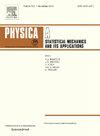基于简明规定时间控制策略的复值记忆神经网络混合投影同步
IF 3.1
3区 物理与天体物理
Q2 PHYSICS, MULTIDISCIPLINARY
Physica A: Statistical Mechanics and its Applications
Pub Date : 2025-03-01
DOI:10.1016/j.physa.2025.130465
引用次数: 0
摘要
研究具有不连续激活的完全复值记忆延迟神经网络的规定时间混合投影同步问题。首先,建立了一个新的定时稳定性引理,其中沉降时间直接作为辅助函数的一个参数,降低了条件的保守性。与一般的研究方法不同,为了简化操作,利用凸分析方法将复值记忆神经网络模型转换为参数不确定的神经网络模型。随后,应用Filippov解理论、规定时间稳定性理论、不等式技术和非分离方法,通过设计控制器,建立了几个新颖而简洁的充分准则,以保证所考虑的系统达到规定时间同步。此外,与一般幂律型规定时间控制器不同,本文设计的规定时间控制器不涉及符号函数和时滞项,且相对较少。特别是,它们的控制增益之一是时间变量而不是常数。并且规定的同步时间与系统的任何初始值和参数无关,可以根据实际需要任意预设。与已有研究相比,本文的混合射影系数是可调整的复值而非实值,并且射影同步、完全同步和反同步是其特殊情况。最后给出了数值模拟结果,验证了所得理论结果的有效性。本文章由计算机程序翻译,如有差异,请以英文原文为准。
Hybrid projective synchronization of complex-valued memristive neural networks via concise prescribed-time control strategies
This article aims to consider the prescribed-time hybrid projective synchronization of fully complex-valued memristive delayed neural networks with discontinuous activation. Above all, a new prescribed-time stability lemma is established, of which the settling time is directly a parameter of the auxiliary function and the conservatism of the conditions is reduced. Unlike common research methods, to simplify the operation, the complex-valued memristive neural network model is converted into one with uncertain parameters in view of the convex analysis approach. Subsequently, applying Filippov’s solution theory, prescribed-time stability theory, inequality techniques, and non-separation method, several novel and concise sufficient criteria are established to ensure the considered systems achieve prescribed-time synchronization by designing some controllers. Additionally, unlike common power-law type prescribed-time controllers, the ones designed in this paper are simpler because they do not involve sign function and time-delay term and have relatively fewer terms. Especially, one of their control gains is a time variable rather than a constant. And the prescribed synchronization time is independent of any initial values and parameters of the system, and can be preset arbitrarily according to actual needs. Compared with existing works, the hybrid projective coefficients of this paper are complex-valued that can be adjusted rather than real-valued, and projective synchronization, complete synchronization and anti-synchronization are its special cases. Eventually, numerical simulation results are furnished to manifest the effectiveness of the acquired theoretical outcomes.
求助全文
通过发布文献求助,成功后即可免费获取论文全文。
去求助
来源期刊
CiteScore
7.20
自引率
9.10%
发文量
852
审稿时长
6.6 months
期刊介绍:
Physica A: Statistical Mechanics and its Applications
Recognized by the European Physical Society
Physica A publishes research in the field of statistical mechanics and its applications.
Statistical mechanics sets out to explain the behaviour of macroscopic systems by studying the statistical properties of their microscopic constituents.
Applications of the techniques of statistical mechanics are widespread, and include: applications to physical systems such as solids, liquids and gases; applications to chemical and biological systems (colloids, interfaces, complex fluids, polymers and biopolymers, cell physics); and other interdisciplinary applications to for instance biological, economical and sociological systems.

 求助内容:
求助内容: 应助结果提醒方式:
应助结果提醒方式:


